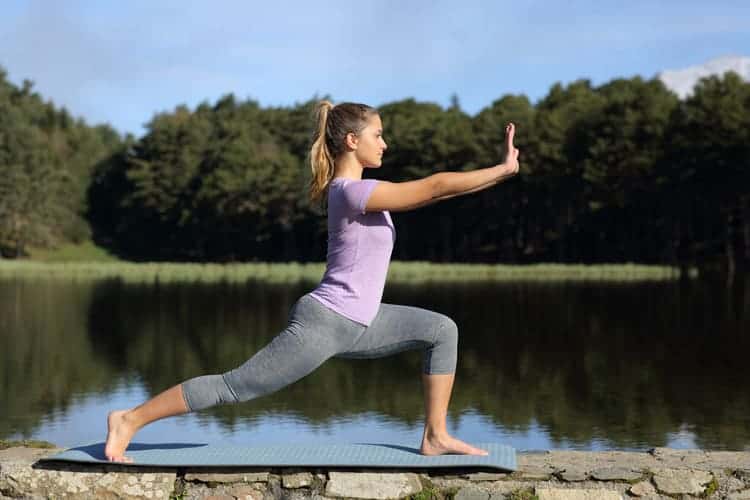
Meditation is a great way to connect with yourself while also reaping many of its benefits (such as improved mental state, less stress and anxiety, better sleep quality, and more). But since there really isn’t anything to “do” during meditation, it’s easy to get bored or distracted with it.
And once that feeling of boredom kicks in, then you can easily find yourself thinking about errands, deadlines, what nail polish color to buy or the fact that you can’t wait for the meditation session to be over!
Whatever the case may be, have no worries. This article is here to give you some practical tips on how to meditate without getting bored.
As you go through this list, choose 1 or 2 suggestions that speak to you and then test them out for a while (at least a week) to see how they work for you.
Let’s go!
10 TIPS FOR MEDITATING WITHOUT GETTING BORED OR DISTRACTED
1. Split Up Your Meditation Practice
When you meditate, you become hyper aware of time and this can make the practice seem interminable and well, boring.
To counteract this, consider splitting up your practice into “mini sessions” throughout the day.
This can help reduce feelings of boredom or distraction during one longer session.
This is also a great strategy to introduce meditation as a habit as opposed to yet another dreadful task on your to-do list.
In fact, according to Andy Puddicomb, founder of the Headspace meditation app – and former monk – “the most important thing is finding a time length which feels achievable and keeps us feeling motivated. Without this, it will never become part of an established daily routine” (source).
2. Start Slow
If you’re new to meditation, it’s best to start slow and get comfortable with the idea of meditating. Look at meditation as a daily habit you are trying to incorporate into your lifestyle long-term.
So rather than aiming for a 30-minute session right off the bat, start with 10 or 15 minutes per day.
Overtime, you can increase the duration as you become comfortable with the practice.
3. Do An Active Meditation

Active meditation is basically any activity that combines movement with mindfulness.
These activities can be especially effective for people who have trouble sitting still or who suffer from chronic pain issues (which can also make sitting meditations difficult).
Here are some ways to practice active meditation:
- Qi-Gong: Qi-Gong is an ancient Chinese exercise and healing practice that focuses on repeating specific movements in order to move “qi” or energy. The repetition naturally helps you to develop more focus and presence, thus quieting the mind.
- Tai-Chi: Tai-Chi is a practice that evolved out of Qi-Gong. It differs from Qi-Gong in that it has more complex sequences and more rules. But like Qi-Gong, the end goal is to move energy and cultivate more awareness.
- Yin Yoga: Yin Yoga is a style of yoga that involves holding poses for several minutes, often about 3 – 10 minutes. As a result, yin yoga allows you to practice being present and aware, even when there’s physical discomfort when holding a pose. At the same time the fact that you change poses every few minutes reduces the risk of boredom.
- Walking: walking – especially in nature – can be a healing and meditative experience, especially when done with intention. To practice walking meditation, simply start by becoming more aware of your steps and how your body feels. You can also become more present with your surroundings, taking the time to observe the colors, textures and sounds.
4. Practice Yoga Before Meditation
Historically, most yoga traditions have done yoga poses aka asanas, before meditation.
There are a few key reasons why this is beneficial:
- Yoga postures are specifically designed to prepare the body for meditation. Increased flexibility and strength allow you to sit more comfortably during meditation.
- Yoga poses often require us to be present with the physical discomfort that we feel. By learning to be present for physical discomfort in a pose, we train the mind to face discomfort. This strength eventually transfers over to meditation where we often face emotional discomfort.
- Yoga poses also cultivate a sense of relaxation. And as the body relaxes, the mind naturally follows. The end result is a calm mental state that can deepen your meditation.
5. Journal First
Taking some time to journal before you meditate can reduce distractions and keep your mind at ease. It’s also an opportunity to write out any intentions you have for your session.
Here are some writing prompts you can use:
- What is something I am grateful for today?
- Where do I feel most at peace?
- What is one thing I can commit to today?
- What are my top values at this time in my life?
- What is a feeling I would like to experience today?
6. Do Breathwork (Pranayama) First
“Pranayama” is the sanskrit word that is used for all yogic breathing techniques, many of which are usually done in a seated position (source).
This breathwork aims to release both physical and mental tension, thus promoting a sense of calm and relaxation before meditation.
The video below provides a good overview of various pranayama practices:
7. Use a Mantra
The sanskrit word mantra – man means mind and tra means vehicle – can be translated to “mind tool” or “mind instrument” (source).
It is a sound that you can repeat silently or out loud, to help keep the mind focused.
If your mind tends to wander during meditation, using mantras is a powerful way to drown out the noise and bring you back to the present moment.
Here are some commonly used mantras and their meanings:
- “Aum” or “Om” – It is, will be, or to become
- “Aham Prema” – I am Divine Love
- “I Am That I Am”
- “Om Tat Sat” – All that is
- “Om Shanti, Shanti, Shanti” – Peace of mind, body, and speech
8. Try a Group Meditation
Similar to gym workouts, having a meditation partner holds you accountable and gives you something to look forward to.
Meditating in a group can provide a sense of harmony and inspiration since you are surrounded by people who are on a similar journey as yours.
9. Follow a Guided Meditation
There’s no doubt that there’s ease in following an expert during meditation – especially when you are just starting out.
Guided meditations offer a step-by-step experience, and can be delivered through an app, websites, or even a free YouTube channel.
Plus, you can choose from different types of meditations based on your needs, schedule, and skill level.
Here are some of my favorite resources for guided meditations:
- Calm: this app offers a variety of meditations and has garnered some attention with its sleep stories (narrated by the likes of Idris Elba, Kate Winslet and other celebs).
- Headspace: an offering a variety of guided meditations.
- Tara Brach: one of the most notable names in the world of mindfulness. She’s known for developing the RAIN – Recognize, Allow, Investigate, Nurture – tool for using mindfulness in our daily lives. Her podcast also features a lot of guided meditations.
- New Horizon: meditation and sleep stories for the little ones.
In addition, some other resources worth checking out are the aps Buddhify and Breethe, plus the YouTube channels Great Meditation and Michael Sealey
Lastly, if face-to-face is more your style, then find a meditation teacher in your area who offers in-person classes.
Here are some resources to help you locate teachers:
10. Remind Yourself of The Purpose of Meditation
Reminding yourself why you started a meditation practice can help you stick with it for the long run.
The main purpose of meditation is to train our minds to observe our thoughts as just that – thoughts.
According to Buddhism, every human being has the potential for enlightenment by mastering the act of mindfulness (source).
While everyone’s purpose for meditating is slightly different, the goal is to feel peace and fulfillment in our everyday lives.
Consistent meditation can help you achieve this – by creating a healthy space for your thoughts and physical being to co-exist.
CONCLUSION
Becoming comfortable with – and enjoying meditation – is something that comes with time, patience, and consistency.
Remember, that this is an always-evolving practice and there is no “one size fits all” when it comes to meditation.
It’s your practice, your journey.
I hope these tips help you on your way!

Related Articles:
No Motivation To Meditate? Try These 8 Tips
How To Meditate Without Your Legs Falling Asleep | Tips That Actually Work

